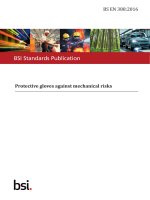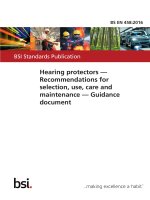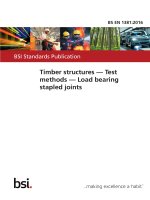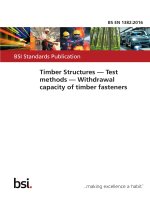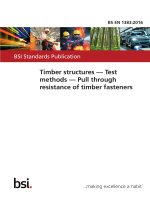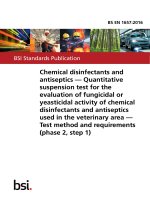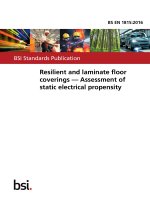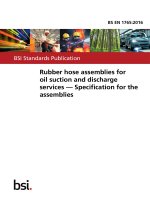Bsi bs en 61140 2016
Bạn đang xem bản rút gọn của tài liệu. Xem và tải ngay bản đầy đủ của tài liệu tại đây (3.2 MB, 62 trang )
BS EN 61140:2016
BSI Standards Publication
Protection against electric
shock — Common aspects for
installation and equipment
BS EN 61140:2016 BRITISH STANDARD
National foreword
This British Standard is the UK implementation of EN 61140:2016. It is
identical to IEC 61140:2016. It supersedes BS EN 61140:2002+A1:2006 which
is withdrawn.
The UK participation in its preparation was entrusted to Technical
Committee JPEL/64, Electrical installations of buildings - Joint committee.
A list of organizations represented on this committee can be obtained on
request to its secretary.
This publication does not purport to include all the necessary provisions of
a contract. Users are responsible for its correct application.
© The British Standards Institution 2016.
Published by BSI Standards Limited 2016
ISBN 978 0 580 81329 0
ICS 13.260; 29.020; 91.140.50
Compliance with a British Standard cannot confer immunity from
legal obligations.
This British Standard was published under the authority of the
Standards Policy and Strategy Committee on 30 June 2016.
Amendments/corrigenda issued since publication
Date Text affected
EUROPEAN STANDARD EN 61140 BS EN 61140:2016
NORME EUROPÉENNE
EUROPÄISCHE NORM May 2016
ICS 13.260; 29.020; 91.140.50 Supersedes EN 61140:2002
English Version
Protection against electric shock - Common aspects for
installation and equipment
(IEC 61140:2016)
Protection contre les chocs électriques - Aspects communs Schutz gegen elektrischen Schlag - Gemeinsame
aux installations et aux matériels Anforderungen für Anlagen und Betriebsmittel
(IEC 61140:2016) (IEC 61140:2016)
This European Standard was approved by CENELEC on 2016-02-11. CENELEC members are bound to comply with the CEN/CENELEC
Internal Regulations which stipulate the conditions for giving this European Standard the status of a national standard without any alteration.
Up-to-date lists and bibliographical references concerning such national standards may be obtained on application to the CEN-CENELEC
Management Centre or to any CENELEC member.
This European Standard exists in three official versions (English, French, German). A version in any other language made by translation
under the responsibility of a CENELEC member into its own language and notified to the CEN-CENELEC Management Centre has the
same status as the official versions.
CENELEC members are the national electrotechnical committees of Austria, Belgium, Bulgaria, Croatia, Cyprus, the Czech Republic,
Denmark, Estonia, Finland, Former Yugoslav Republic of Macedonia, France, Germany, Greece, Hungary, Iceland, Ireland, Italy, Latvia,
Lithuania, Luxembourg, Malta, the Netherlands, Norway, Poland, Portugal, Romania, Slovakia, Slovenia, Spain, Sweden, Switzerland,
Turkey and the United Kingdom.
European Committee for Electrotechnical Standardization
Comité Européen de Normalisation Electrotechnique
Europäisches Komitee für Elektrotechnische Normung
CEN-CENELEC Management Centre: Avenue Marnix 17, B-1000 Brussels
© 2016 CENELEC All rights of exploitation in any form and by any means reserved worldwide for CENELEC Members.
Ref. No. EN 61140:2016 E
BS EN 61140:2016
EN 61140:2016
European foreword
The text of document 64/2076/FDIS, future edition 4 of IEC 61140, prepared by IEC/TC 64 "Electrical
installations and protection against electric shock" was submitted to the IEC-CENELEC parallel vote
and approved by CENELEC as EN 61140:2016.
The following dates are fixed:
• latest date by which the document has to be implemented at (dop) 2016-11-27
national level by publication of an identical national
standard or by endorsement
• latest date by which the national standards conflicting with (dow) 2019-05-27
the document have to be withdrawn
This document supersedes EN 61140:2002.
Attention is drawn to the possibility that some of the elements of this document may be the subject of
patent rights. CENELEC [and/or CEN] shall not be held responsible for identifying any or all such
patent rights.
This document has been prepared under a mandate given to CENELEC by the European Commission
and the European Free Trade Association.
Endorsement notice
The text of the International Standard IEC 61140:2016 was approved by CENELEC as a European
Standard without any modification.
In the official version, for Bibliography, the following notes have to be added for the standards indicated:
IEC 60364-4-41:2005 NOTE Harmonized as HD 60364-4-41:2007 (modified).
IEC 60364-4-44:2007 NOTE Harmonized as HD 60364-4-442:2012 (modified)
and as HD 60364-4-444:2010 (modified).
IEC 60364-6:2006 NOTE Harmonized as HD 60364-6:2007 (modified).
IEC 60601-1 NOTE Harmonized as EN 60601-1.
IEC 61558-2-6 NOTE Harmonized as EN 61558-2-6.
IEC 61936-1 NOTE Harmonized as EN 61936-1.
2
BS EN 61140:2016
EN 61140:2016
Annex ZA
(normative)
Normative references to international publications
with their corresponding European publications
The following documents, in whole or in part, are normatively referenced in this document and are
indispensable for its application. For dated references, only the edition cited applies. For undated
references, the latest edition of the referenced document (including any amendments) applies.
NOTE 1 When an International Publication has been modified by common modifications, indicated by (mod),
the relevant EN/HD applies.
NOTE 2 Up-to-date information on the latest versions of the European Standards listed in this annex is
available here: www.cenelec.eu.
Publication Year Title EN/HD Year
IEC 60038 - EN 60038 -
IEC 60068 series IEC standard voltages EN 60068 series
IEC 60071-1 - EN 60071-1 -
IEC 60071-2 - Environmental testing EN 60071-2 -
IEC 60364-5-54 2011 HD 60364-5-54 2011
Insulation co-ordination -
IEC 60417 - Part 1: Definitions, principles and rules - -
IEC 60445 - EN 60445 -
Insulation co-ordination -
IEC/TS 60479-1 2005 Part 2: Application guide - -
-
IEC/TR 60479-5 - Low-voltage electrical installations - -
Part 5-54: Selection and erection of -
IEC 60529 - electrical equipment - Earthing EN 60529 series
IEC 60664 series arrangements and protective conductors EN 60664 2007
IEC 60664-1 2007 EN 60664-1
Graphical symbols for use on equipment 3
Basic and safety principles for man-
machine interface, marking and
identification - Identification of
equipment terminals, conductor
terminations and conductors
Effects of current on human beings and
livestock -
Part 1: General aspects
Effects of current on human beings and
livestock -
Part 5: Touch voltage threshold values
for physiological effects
Degrees of protection provided by
enclosures (IP Code)
Insulation coordination for equipment
within low-voltage systems
Insulation coordination for equipment
within low-voltage systems -
Part 1: Principles, requirements and
tests
BS EN 61140:2016
EN 61140:2016
Publication Year Title EN/HD Year
IEC 60721 series EN 60721 series
IEC 60990 - Classification of environmental EN 60990 -
IEC/TS 61201 2007 conditions - -
IEC 62271-102 - EN 62271-102 -
Methods of measurement of touch
IEC Guide 104 - current and protective conductor current - -
ISO/IEC Guide 51 2014 Use of conventional touch voltage - -
limits - Application guide
High-voltage switchgear and
controlgear -
Part 102: Alternating current
disconnectors and earthing switches
The preparation of safety publications
and the use of basic safety publications
and group safety publications
Safety aspects - Guidelines for their
inclusion in standards
4
– 2 – BS EN 61140:2016
IEC 61140:2016 © IEC 2016
CONTENTS
FOREW ORD ........................................................................................................................... 5
1 Scope ..............................................................................................................................7
2 Normative references ......................................................................................................7
3 Terms and definitions ......................................................................................................8
4 Fundamental rule of protection against electric shock ....................................................18
4.1 General................................................................................................................. 18
4.2 Normal conditions ................................................................................................. 19
4.3 Single-fault conditions...........................................................................................20
4.3.1 General ......................................................................................................... 20
4.3.2 Protection by independent protective provisions ............................................20
4.3.3 Protection by an enhanced protective provision .............................................20
4.4 Additional protection ............................................................................................. 20
4.5 Protection against electric burns ........................................................................... 21
4.6 Protection against physiological effects without adverse health effect ...................21
4.6.1 General ......................................................................................................... 21
4.6.2 Muscular reaction .......................................................................................... 21
4.6.3 Effects of touch current of discharge of electrostatic charges.........................22
4.6.4 Thermal effects..............................................................................................22
5 Protective provisions (elements of protective measures)................................................22
5.1 General................................................................................................................. 22
5.2 Provisions for basic protection .............................................................................. 22
5.2.1 General ......................................................................................................... 22
5.2.2 Basic insulation ............................................................................................. 22
5.2.3 Protective barriers or enclosures ................................................................... 23
5.2.4 Obstacles ...................................................................................................... 23
5.2.5 Placing out of arm's reach .............................................................................23
5.2.6 Limitation of voltage ...................................................................................... 24
5.2.7 Limitation of steady-state touch current and energy .......................................24
5.2.8 Potential grading ........................................................................................... 25
5.2.9 Other provisions for basic protection..............................................................25
5.3 Provisions for fault protection................................................................................25
5.3.1 General ......................................................................................................... 25
5.3.2 Supplementary insulation...............................................................................25
5.3.3 Protective-equipotential-bonding.................................................................... 25
5.3.4 Protective screening ...................................................................................... 27
5.3.5 Indication and disconnection in high-voltage installations and systems ..........27
5.3.6 Automatic disconnection of supply .................................................................27
5.3.7 Simple separation (between circuits) .............................................................28
5.3.8 Non-conducting environment .........................................................................28
5.3.9 Potential grading ........................................................................................... 28
5.3.10 Other provisions for fault protection ...............................................................28
5.4 Enhanced protective provisions.............................................................................28
5.4.1 General ......................................................................................................... 28
5.4.2 Reinforced insulation ..................................................................................... 29
5.4.3 Protective separation between circuits ...........................................................29
5.4.4 Limited current source ...................................................................................29
BS EN 61140:2016 – 3 –
IEC 61140:2016 © IEC 2016
5.4.5 Protective impedance device .........................................................................29
5.4.6 Other provisions for enhanced protection.......................................................30
5.5 Provisions for additional protection ....................................................................... 30
5.5.1 Additional protection by residual current protective device (RCD)
5.5.2 I∆n ≤ 30 mA...................................................................................................30
Additional protection by supplementary equipotential bonding .......................30
6 Protective measures ...................................................................................................... 30
6.1 General................................................................................................................. 30
6.2 Protection by automatic disconnection of supply ...................................................31
6.3 Protection by double or reinforced insulation.........................................................31
6.4 Protection by protective equipotential bonding ......................................................31
6.5 Protection by electrical separation ........................................................................31
6.6 Protection by non-conducting environment (low-voltage).......................................31
6.7 Protection by SELV system ................................................................................... 32
6.8 Protection by PELV system ................................................................................... 32
6.9 Protection by limitation of steady-state touch current and charge ..........................32
6.10 Additional protection ............................................................................................. 32
6.10.1 Additional protection by residual current protective device (RCD)
6.10.2 I∆n ≤ 30 mA...................................................................................................32
Additional protection by supplementary protective equipotential bonding .......32
6.11 Protection by other measures ...............................................................................33
7 Co-ordination between electrical equipment and protective provisions within an
electrical installation ...................................................................................................... 33
7.1 General................................................................................................................. 33
7.2 Class 0 equipment ................................................................................................ 33
7.3 Class I equipment ................................................................................................. 34
7.3.1 General ......................................................................................................... 34
7.3.2 Insulation....................................................................................................... 34
7.3.3 Connection to the protective conductor ..........................................................34
7.3.4 Accessible surfaces of parts of insulating material .........................................34
7.3.5 Connection of a protective conductor .............................................................35
7.4 Class II equipment ................................................................................................ 35
7.4.1 General ......................................................................................................... 35
7.4.2 Insulation....................................................................................................... 35
7.4.3 Protective bonding ......................................................................................... 36
7.4.4 Marking ......................................................................................................... 36
7.5 Class III equipment ............................................................................................... 36
7.5.1 General ......................................................................................................... 36
7.5.2 Voltages ........................................................................................................ 36
7.5.3 Protective bonding ......................................................................................... 37
7.5.4 Marking ......................................................................................................... 37
7.6 Touch currents, protective conductor currents.......................................................37
7.6.1 General ......................................................................................................... 37
7.6.2 Touch currents .............................................................................................. 37
7.6.3 Protective conductor currents ........................................................................ 37
7.6.4 Other requirements........................................................................................39
7.6.5 Other effects..................................................................................................39
7.7 Safety and boundary clearances and hazard marking for high-voltage
installations .......................................................................................................... 39
– 4 – BS EN 61140:2016
IEC 61140:2016 © IEC 2016
7.8 Functional earthing ............................................................................................... 40
8 Special operating and servicing conditions ....................................................................40
8.1 General................................................................................................................. 40
8.2 Devices to be operated manually and components intended to be replaced
manually ............................................................................................................... 40
8.2.1 General ......................................................................................................... 40
8.2.2 Devices to be operated or components intended to be replaced by
ordinary persons in low-voltage installations, systems and equipment ...........40
8.2.3 Devices to be operated or components intended to be replaced by
skilled or instructed persons .......................................................................... 41
8.3 Electrical values after isolation..............................................................................41
8.4 Devices for isolation.............................................................................................. 42
8.4.1 General ......................................................................................................... 42
8.4.2 Devices for isolation for low voltage...............................................................42
8.4.3 Devices for isolation for high voltage .............................................................43
Annex A (informative) Survey of protective measures as implemented by protective
provisions ............................................................................................................................. 45
Annex B (informative) Index of terms ...................................................................................48
Annex C (informative) List of notes concerning certain countries .........................................53
Bibliography.......................................................................................................................... 54
Figure A.1 – Protective measures with basic and fault protection ..........................................45
Figure A.2 – Protective measures with limited values of electrical quantities .........................46
Figure A.3 – Protective measure: additional protection (in addition to basic and/or fault
protection) ............................................................................................................................ 47
Table 1 – Limits for voltage bands ........................................................................................ 19
Table 2 – Touch voltage thresholds for reaction ....................................................................21
Table 3 – Application of equipment in a low-voltage installation ............................................33
Table 4 – Maximum protective conductor current for frequencies up to 1 kHz .......................38
Table 5 – Maximum protective conductor current for DC .......................................................38
Table 6 – Minimum impulse withstand voltage of devices for isolation related to the
nominal voltage .................................................................................................................... 43
BS EN 61140:2016 – 5 –
IEC 61140:2016 © IEC 2016
INTERNATIONAL ELECTROTECHNICAL COMMISSION
____________
PROTECTION AGAINST ELECTRIC SHOCK –
COMMON ASPECTS FOR INSTALLATION AND EQUIPMENT
FOREWORD
1) The International Electrotechnical Commission (IEC) is a worldwide organization for standardization comprising
all national electrotechnical committees (IEC National Committees). The object of IEC is to promote
international co-operation on all questions concerning standardization in the electrical and electronic fields. To
this end and in addition to other activities, IEC publishes International Standards, Technical Specifications,
Technical Reports, Publicly Available Specifications (PAS) and Guides (hereafter referred to as “IEC
Publication(s)”). Their preparation is entrusted to technical committees; any IEC National Committee interested
in the subject dealt with may participate in this preparatory work. International, governmental and non-
governmental organizations liaising with the IEC also participate in this preparation. IEC collaborates closely
with the International Organization for Standardization (ISO) in accordance with conditions determined by
agreement between the two organizations.
2) The formal decisions or agreements of IEC on technical matters express, as nearly as possible, an international
consensus of opinion on the relevant subjects since each technical committee has representation from all
interested IEC National Committees.
3) IEC Publications have the form of recommendations for international use and are accepted by IEC National
Committees in that sense. While all reasonable efforts are made to ensure that the technical content of IEC
Publications is accurate, IEC cannot be held responsible for the way in which they are used or for any
misinterpretation by any end user.
4) In order to promote international uniformity, IEC National Committees undertake to apply IEC Publications
transparently to the maximum extent possible in their national and regional publications. Any divergence
between any IEC Publication and the corresponding national or regional publication shall be clearly indicated in
the latter.
5) IEC itself does not provide any attestation of conformity. Independent certification bodies provide conformity
assessment services and, in some areas, access to IEC marks of conformity. IEC is not responsible for any
services carried out by independent certification bodies.
6) All users should ensure that they have the latest edition of this publication.
7) No liability shall attach to IEC or its directors, employees, servants or agents including individual experts and
members of its technical committees and IEC National Committees for any personal injury, property damage or
other damage of any nature whatsoever, whether direct or indirect, or for costs (including legal fees) and
expenses arising out of the publication, use of, or reliance upon, this IEC Publication or any other IEC
Publications.
8) Attention is drawn to the Normative references cited in this publication. Use of the referenced publications is
indispensable for the correct application of this publication.
9) Attention is drawn to the possibility that some of the elements of this IEC Publication may be the subject of
patent rights. IEC shall not be held responsible for identifying any or all such patent rights.
International Standard IEC 61140 has been prepared by IEC technical committee 64:
Electrical installations and protection against electric shock.
This fourth edition cancels and replaces the third edition published in 2001 and
Amendment 1:2004. This edition constitutes a technical revision.
This edition includes the following significant technical changes with respect to the previous
edition:
a) Introduction of the content of IEC 60449
b) Better distinction between provisions and measures
c) Consideration of effects other than ventricular fibrillation
d) Additional protection was introduced
e) ELV defined as part of LV
f) Devices suitable for isolation required for automatic disconnection of supply (LV)
– 6 – BS EN 61140:2016
IEC 61140:2016 © IEC 2016
g) Requirements relating to current in the protective conductor were moved to the main body
of the standard
The text of this standard is based on the following documents:
FDIS Report on voting
64/2076/FDIS 64/2091/RVD
Full information on the voting for the approval of this standard can be found in the report on
voting indicated in the above table.
This publication has been drafted in accordance with the ISO/IEC Directives, Part 2.
It has the status of a basic safety publication in accordance with IEC Guide 104.
The reader's attention is drawn to the fact that Annex C lists all of the “in-some-country”
clauses on differing practices of a less permanent nature relating to the subject of this
standard.
The committee has decided that the contents of this publication will remain unchanged until
the stability date indicated on the IEC website under "" in the data
related to the specific publication. At this date, the publication will be
• reconfirmed,
• withdrawn,
• replaced by a revised edition, or
• amended.
BS EN 61140:2016 – 7 –
IEC 61140:2016 © IEC 2016
PROTECTION AGAINST ELECTRIC SHOCK –
COMMON ASPECTS FOR INSTALLATIONS AND EQUIPMENT
1 Scope
This International Standard is a basic safety publication primarily intended for use by
technical committees in the preparation of standards in accordance with the principles laid
down in IEC Guide 104 and ISO/IEC Guide 51.
It is not intended to be used as a stand-alone standard.
According to IEC Guide 104, technical committees, when preparing, amending, or revising
their publications, are required to make use of any basic safety publication such as IEC 61140.
This International Standard applies to the protection of persons and livestock against electric
shock. The intent is to give fundamental principles and requirements which are common to
electrical installations, systems and equipment or necessary for their coordination, without
limitations with regard to the magnitude of the voltage or current, or the type of current, and
for frequencies up to 1 000 Hz.
Some clauses in this standard refer to low-voltage and high-voltage systems, installations and
equipment. For the purposes of this standard, low-voltage is any rated voltage up to and
including 1 000 V a.c. or 1 500 V d.c.. High voltage is any rated voltage exceeding
1 000 V a.c. or 1 500 V d.c..
It should be noted that, for an efficient design and selection of protective measures, the type
of voltage that may occur and its waveform needs to be considered, i.e. a.c. or d.c. voltage,
sinusoidal, transient, phase controlled, superimposed d.c., as well as a possible mixture of
these forms. The installations or equipment may influence the waveform of the voltage, e.g.
by inverters or converters. The currents flowing under normal operating conditions and under
fault conditions depend on the described voltage.
2 Normative references
The following documents, in whole or in part, are normatively referenced in this document and
are indispensable for its application. For dated references, only the edition cited applies. For
undated references, the latest edition of the referenced document (including any
amendments) applies.
IEC 60038, IEC standard voltages
IEC 60068 (all parts), Environmental testing
IEC 60071-1, Insulation coordination – Part 1: Definitions, principles and rules
IEC 60071-2, Insulation coordination – Part 2: Application guide
IEC 60364-5-54:2011, Low-voltage electrical installations – Part 5-54: Selection and erection
of electrical equipment – Earthing arrangements and protective conductors
IEC 60417, Graphical symbols for use on equipment
(available at phicalsymbols.info/equipment)
– 8 – BS EN 61140:2016
IEC 61140:2016 © IEC 2016
IEC 60445, Basic and safety principles for man-machine interface, marking and identification
– Identification of equipment terminals, conductor terminations and conductors
IEC TS 60479-1:2005, Effects of current on human beings and livestock – Part 1: General
aspects
IEC TR 60479-5, Effects of current on human beings and livestock – Part 5: Touch voltage
threshold values for physiological effects
IEC 60529, Degrees of protection provided by enclosure (IP Code)
IEC 60664 (all parts), Insulation coordination for equipment within low-voltage systems
IEC 60664-1:2007, Insulation coordination for equipment within low-voltage systems – Part 1:
Principles, requirements and tests
IEC 60721 (all parts), Classification of environmental conditions
IEC 60990, Methods of measurement of touch current and protective conductor current
IEC TS 61201:2007, Use of conventional touch voltage limits – Application guide
IEC 62271-102, High-voltage switchgear and controlgear – Part 102: Alternating current
disconnectors and earthing switches
IEC Guide 104, The preparation of safety publications and the use of basic safety publications
and group safety publications
ISO/IEC Guide 51:2014, Safety aspects – Guidelines for their inclusion in standards
3 Terms and definitions
For the purposes of this document, the following terms and definitions apply.
NOTE An index of definitions is given in Annex B.
3.1
electric shock
physiological effect resulting from an electric current through a human body or livestock
Note 1 to entry: Physiological effects include, for example, perception, muscular contractions and tetany, difficulty
in breathing, disturbances of heart function, immobilization, cardiac arrest, breathing arrest, burns or other cellular
damage.
Note 2 to entry: Physiological effects resulting from EMF are not considered in this standard.
[SOURCE: IEC 60050-195:1998, 195-01-04, modified – "through a human body or livestock"
replaces "passing through a human or animal body"; addition of 2 Notes to entry]
3.1.1
basic protection
protection against electric shock under fault-free conditions
[SOURCE: IEC 60050-195:1998, 195-06-01]
BS EN 61140:2016 – 9 –
IEC 61140:2016 © IEC 2016
3.1.2
fault protection
protection against electric shock under single fault conditions
[SOURCE: IEC 60050-195:1998/AMD1:2001, 195-06-02]
3.1.3
additional protection
protection against electric shock in addition to basic protection and/or fault protection
[SOURCE:IEC 60050-826:2004, 826-12-07, modified – “protection against electric shock”
replaces “protective measure”]
3.1.4
single fault condition
condition in which one means for protection against electric shock is defective or one fault is
present which could cause a hazard
Note 1 to entry: If a single fault condition results in one or more other fault conditions, all are considered as one
single fault condition.
3.2
electric circuit
arrangement of devices or media through which electric current can flow
Note 1 to entry: See also IEC 60050-826:2004, 826-14-01 for electrical installations of buildings.
3.3
electrical equipment
item used for such purposes as generation, conversion, transmission, distribution or utilization
of electric energy, such as electric machines, transformers, switchgear and controlgear,
measuring instruments, protective devices, wiring systems, current-using equipment
[SOURCE: IEC 60050-826:2004, 826-16-01]
3.4
live part
conductive part intended to be energized in normal conditions, including a neutral conductor
or mid-point conductor, but by convention not a PEN conductor or PEM conductor or PEL
conductor
Note 1 to entry: This concept does not necessarily imply a risk of electric shock.
[SOURCE: IEC 60050-195:1998, 195-02-19, modified – “…normal conditions, including a
neutral conductor or mid-point conductor” replaces “normal operation, including a neutral
conductor..”]
3.5
hazardous-live-part
live part which, under certain conditions, can give a harmful electric shock
Note 1 to entry: In case of high voltage, a hazardous voltage may be present on the surface of solid insulation. In
such a case the surface is considered to be a hazardous-live-part.
[SOURCE: IEC 60050-195:1998, 195-06-05]
3.6
exposed-conductive-part
conductive part of equipment, which can be touched and which is not normally live, but which
can become live when basic insulation fails
– 10 – BS EN 61140:2016
IEC 61140:2016 © IEC 2016
Note 1 to entry: A conductive part of electrical equipment which can become live only through contact with an
exposed-conductive-part which has become live, is not considered to be an exposed-conductive-part itself.
[SOURCE: IEC 60050-195:1998, 195-06-10]
3.7
extraneous-conductive-part
conductive part not forming part of the electrical installation and liable to introduce an electric
potential, generally the electric potential of a local earth
[SOURCE: IEC 60050-195:1998, 195-06-11]
3.8
touch voltage
3.8.1
(effective) touch voltage
voltage between conductive parts when touched simultaneously by a human or livestock
Note 1 to entry: The value of the effective touch voltage may be appreciably influenced by the impedance of the
person or the livestock in electric contact with these conductive parts.
[SOURCE: IEC 60050-195:1998, 195-05-11, modified – “by a human or livestock” replaces “by
a person or an animal”]
3.8.2
prospective touch voltage
voltage between simultaneously accessible conductive parts when those conductive parts are
not being touched, by a human or livestock
[SOURCE: IEC 60050-195:1998, 195-05-09, modified – “by a human or livestock” replaces “by
a person or an animal”]
3.9 livestock when it touches one or
touch current
electric current passing through a human body or through
more accessible parts of an installation or of equipment
[SOURCE: IEC 60050-195:1998/AMD1:2001, 195-05-21, modified – “through livestock”
replaces “through an animal body”]
3.10
insulation
set of properties which characterize the ability of an insulation to provide its function
Note 1 to entry: Examples of relevant properties are: resistance, breakdown voltage.
Note 2 to entry: Insulation can be a solid, a liquid or a gas (e.g. air), or any combination.
[SOURCE: IEC 60050-151:2001, 151-15-42, modified – Note 2 to entry added]
3.10.1
basic insulation
insulation of hazardous-live-parts which provides basic protection
Note 1 to entry: This concept does not apply to insulation used exclusively for functional purposes.
[SOURCE: IEC 60050-195:1998, 195-06-06]
BS EN 61140:2016 – 11 –
IEC 61140:2016 © IEC 2016
3.10.2
supplementary insulation
independent insulation applied in addition to basic insulation, for fault protection
[SOURCE: IEC 60050-195:1998, 195-06-07]
3.10.3
double insulation
insulation comprising both basic insulation and supplementary insulation
[SOURCE: IEC 60050-195:1998, 195-06-08]
3.10.4
reinforced insulation
insulation of hazardous-live-parts which provides protection against electric shock equivalent
to double insulation
Note 1 to entry: Reinforced insulation may comprise several layers which cannot be tested singly as basic
insulation or supplementary insulation.
[SOURCE: IEC 60050-195:1998, 195-06-09, modified – ..provides “a degree” of …, deleted]
3.11
non-conducting environment
provision whereby a human or livestock touching an exposed-conductive-part that has
become hazardous-live is protected by the high impedance of his environment (e.g. insulating
walls and floors) and by the absence of earthed conductive parts
[SOURCE: IEC 60050-195:1998, 195-06-21, modified – “animal” replaced by “livestock”]
3.12
(electrically) protective obstacle
part preventing unintentional contact by a human or livestock with a live part, but not
preventing such contact by deliberate action
[SOURCE: IEC 60050-195:1998, 195-06-16, modified – "direct contact" replaced by "contact"
and ”by a human or livestock with a live part”.. introduced]
3.13
(electrically) protective barrier
part providing protection against contact by a human or livestock with a live part from any
usual direction of access
[SOURCE: IEC 60050-195:1998, 195-06-15, modified – "direct contact" replaced by "contact"
and “by a human or livestock with a live part” … introduced]
3.14
(electrically) protective enclosure
electrical enclosure surrounding internal parts of equipment to prevent access to a live-part
from any direction
Note 1 to entry: In addition, an enclosure generally provides protection against internal or external influences, e.g.
ingress of dust or water or prevention of mechanical damage.
[SOURCE: IEC 60050-195:1998, 195-06-14, modified – "hazardous live-parts" replaced by "a
live-part" and Note 1 to entry added]
– 12 – BS EN 61140:2016
IEC 61140:2016 © IEC 2016
3.15
arm's reach
zone of accessibility to touch extending from any point on a surface where persons usually
stand or move about to the limits which a person can reach with the hand, in any direction,
without assistance
[SOURCE: IEC 60050-195:1998, 195-06-12]
3.16
equipotential bonding
provision of electric connections between conductive parts intended to achieve
equipotentiality
Note 1 to entry: The effectiveness of the equipotential bonding may depend on the frequency of the current in the
bonding.
[SOURCE: IEC 60050-195:1998, 195-01-10, modified – Note 1 to entry added]
3.16.1
protective-equipotential-bonding
equipotential bonding for the purposes of safety (e.g. protection against electric shock)
Note 1 to entry: Functional equipotential bonding is defined in IEC 60050-195:1998, 195-01-16.
[SOURCE: IEC 60050-195:1998, 195-01-15, modified – “(e.g. protection against electric
shock)” introduced and Note 1 to entry added]
3.16.2
equipotential bonding terminal
terminal provided on equipment or on a device and intended for the electric connection with
the equipotential bonding system
[SOURCE: IEC 60050-195:1998, 195-02-32]
3.16.3
protective bonding terminal
terminal intended for protective-equipotential-bonding purposes
3.16.4
protective conductor
conductor provided for purposes of safety, for example protection against electric shock
[SOURCE: IEC 60050-195:1998, 195-02-09]
3.16.5
PE conductor
protective conductor provided for protective earthing
[SOURCE: IEC 60050-195:1998, 195-02-11, modified – term title changed]
3.16.6
PEN conductor
conductor combining the functions of both a protective earthing conductor and a neutral
conductor
[SOURCE: IEC 60050-195:1998, 195-02-12]
BS EN 61140:2016 – 13 –
IEC 61140:2016 © IEC 2016
3.16.7
PEM conductor
conductor combining the functions of both a protective earthing conductor and a mid-point
conductor
[SOURCE: IEC 60050-195:1998, 195-02-13]
3.16.8
PEL conductor
conductor combining the functions of both a protective earthing conductor and a line
conductor
[SOURCE: IEC 60050-195:1998, 195-02-14]
3.16.9
protective bonding conductor
protective conductor provided for protective-equipotential-bonding
[SOURCE: IEC 60050-195:1998, 195-02-10]
3.16.10
line conductor
DEPRECATED: phase conductor (in AC systems)
DEPRECATED: pole conductor (in DC systems)
conductor which is energized in normal operation and capable of contributing to the
transmission or distribution of electric energy but which is not a neutral or mid-point conductor
[SOURCE: IEC 60050-195:1998, 195-02-08]
3.16.11
neutral conductor
conductor electrically connected to the neutral point and capable of contributing to the
distribution of electric energy
[SOURCE: IEC 60050-195:1998, 195-02-06]
3.17
earth
concept embracing the planet and all its physical matter
3.17.1
earth (verb)
ground (verb) (US)
to make an electrical connection between local earth and a given point in a system,
installation or equipment
Note 1 to entry: The connection to local earth may be:
– intentional; or
– unintentional; or
– accidental
and may be permanent or temporary.
3.17.2
reference earth
reference ground (US)
part of the Earth considered as conductive, the electric potential of which is conventionally
taken as zero, being outside the zone of influence of any earthing arrangement
– 14 – BS EN 61140:2016
IEC 61140:2016 © IEC 2016
[SOURCE: IEC 60050-195:1998, 195-01-01, modified – Note deleted]
3.17.3
(local) earth
(local) ground (US)
part of the Earth which is in electric contact with an earth electrode and the electric potential
of which is not necessarily equal to zero
[SOURCE: IEC 60050-195:1998, 195-01-03]
3.17.4
earth electrode
ground electrode (US)
conductive part, which may be embedded in a specific conductive medium, e.g. concrete or
coke, in electric contact with the Earth
[SOURCE: IEC 60050-195:1998, 195-02-01]
3.17.5
earthing conductor
grounding conductor (US)
conductor which provides a conductive path, or part of the conductive path, between a given
point in a system or in an installation or in equipment and an earth electrode
[SOURCE: IEC 60050-195:1998, 195-02-03]
3.17.6
earthing arrangement
grounding arrangement (US)
all the electric connections and devices involved in the earthing of a system, an installation
and equipment
Note 1 to entry: This could be a locally limited arrangement of interconnected earth electrodes on the high-
voltage side.
[SOURCE: IEC 60050-195:1998, 195-02-20, modified – Note 1 to entry added]
3.17.7
protective earthing
protective grounding (US)
earthing a point or points in a system or in an installation or in equipment for purposes of
electrical safety
[SOURCE: IEC 60050-195:1998/AMD1:2001, 195-01-11]
3.17.8
functional earthing
functional grounding (US)
earthing a point or points in a system or in an installation or in equipment for purposes other
than electrical safety
[SOURCE: IEC 60050-195:1998/AMD1:2001, 195-01-13]
3.18
automatic disconnection of supply
interruption of one or more of the line conductors effected by the automatic operation of a
protective device in the event of a fault
BS EN 61140:2016 – 15 –
IEC 61140:2016 © IEC 2016
Note 1 to entry: This does not necessarily mean an interruption in all conductors of the supply system.
[SOURCE: IEC 60050-195:1998, 195-04-10, modified – “in the event of a fault” replaces “in
case of a fault” and Note 1 to entry added]
3.19
enhanced protective provision
protective provision having a reliability of protection not less than that provided by two
independent protective provisions
3.20
(conductive) screen
(conductive) shield (US)
conductive part that encloses or separates electric circuits and/or conductors
[SOURCE: IEC 60050-195:1998/AMD1:2001, 195-02-38]
3.21
(electrically) protective screen
(electrically) protective shield (US)
conductive screen (shield) used to separate an electric circuit and/or conductors from
hazardous-live-parts
[SOURCE: IEC 60050-195:1998/AMD1:2001, 195-06-17]
3.22
(electrically) protective screening
(electrically) protective shielding (US)
separation of electric circuits or conductors from hazardous-live-parts by an electrically
protective screen connected to the protective-equipotential-bonding system and intended to
provide protection against electric shock
[SOURCE: IEC 60050-195:1998/AMD1:2001, 195-06-18]
3.23
simple separation
separation between electric circuits or between an electric circuit and local earth by means of
basic insulation
[SOURCE: IEC 60050-826:2004, 826-12-28]
3.24
(electrically) protective separation
separation of one electric circuit from another by means of:
– double insulation; or
– basic insulation and electrically protective screening (shielding); or
– reinforced insulation
[SOURCE: IEC 60050-195:1998/AMD1:2001, 195-06-19]
3.25
(electrical) separation
protective measure in which hazardous-live-parts are insulated from all other electric circuits
and parts, from local earth and from touch
[SOURCE: IEC 60050-826:2004, 826-12-27]

